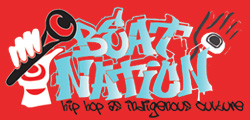
For those of you who couldn’t find it when Shirley mentioned it in the discussion form, here is the link to BeatNation. For anybody interested in a youth culture, this is a MUST SEE!/ LISTEN!! There are a bunch of tracks here and the dialogue and respect shown even in the text is absolutely fantastic. I will definitely be looking into the history of the aboriginal hip-hop movement much more closely as a result of this. And if it hasn’t been done already, I am sure there is some incredible research value in that topic. I am sure that people like Amy Metcalf and her teachers have contributed to scholarship around this, but it is definitely my first real encounter and all kinds of questions arise because of it.
For example, how many other hip-hop artists are using traditional language in their recordings? I am sure that I’ve heard Australian aboriginal hip-hop, but I don’t have any exact references to draw from. Also, how many different aboriginal languages are being used in hip-hop? And probably most importantly, how useful could hip-hop be in engaging aboriginal youth and preserving indigenous language?
Of course when it comes to hip hop it’s very easy to compare the plight of African-Americans and the plight of First Nations people. As we learned, many aboriginal groups around the world feel and felt a kinship with African-Americans during the civil rights movement. And there’s no question that hip-hop is vitally important in African-American culture and is born from the sentiment fo the civil rights movement. So it should come as no surprise that there are First Nations artists taking the lead from African-Americans. And the thing that comes to mind for some reason when I think about hip-hop, are the Brer bear and Brer rabbit folktales, which are extremely similar in many ways to the oral traditions of First Nations culture. Interesting stuff and at the very least a great chance to listen to Dreamwarriors again for the first time in a long-time!